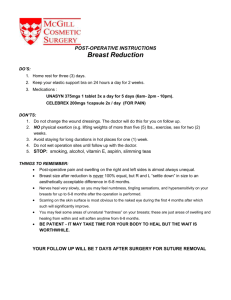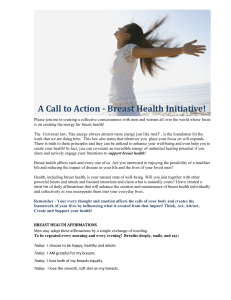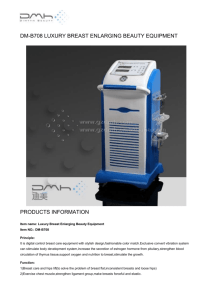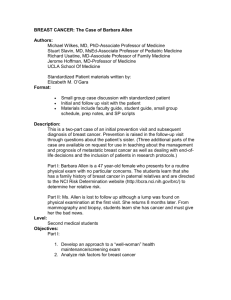October 1, 2013 Fibrocystic Breasts
advertisement
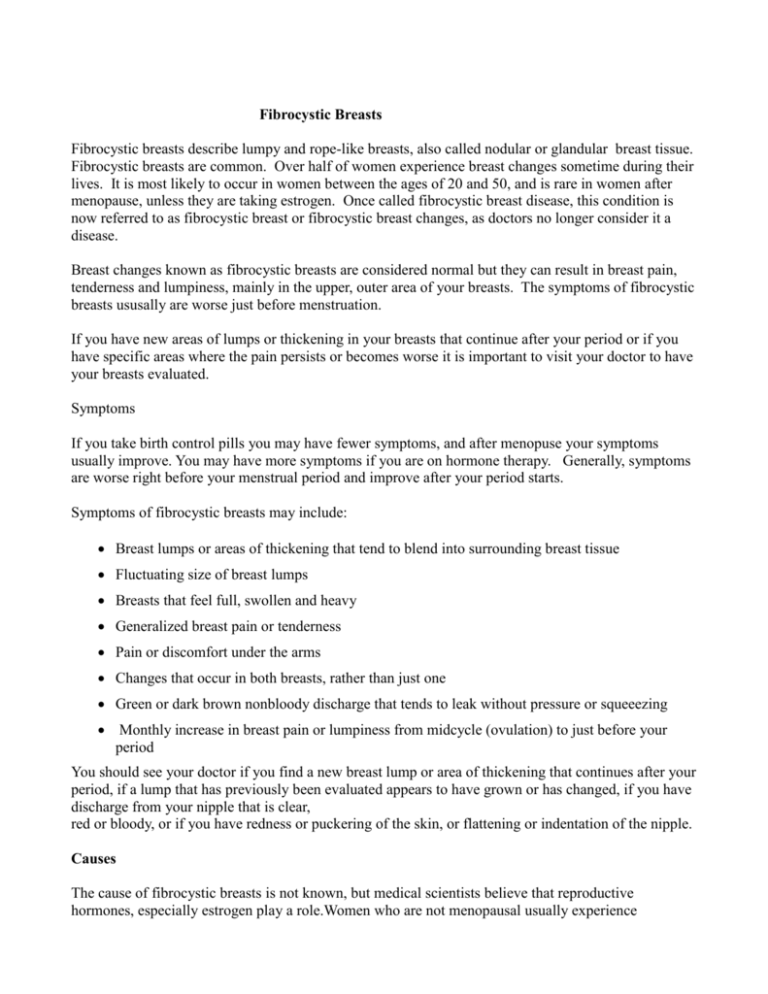
Fibrocystic Breasts Fibrocystic breasts describe lumpy and rope-like breasts, also called nodular or glandular breast tissue. Fibrocystic breasts are common. Over half of women experience breast changes sometime during their lives. It is most likely to occur in women between the ages of 20 and 50, and is rare in women after menopause, unless they are taking estrogen. Once called fibrocystic breast disease, this condition is now referred to as fibrocystic breast or fibrocystic breast changes, as doctors no longer consider it a disease. Breast changes known as fibrocystic breasts are considered normal but they can result in breast pain, tenderness and lumpiness, mainly in the upper, outer area of your breasts. The symptoms of fibrocystic breasts ususally are worse just before menstruation. If you have new areas of lumps or thickening in your breasts that continue after your period or if you have specific areas where the pain persists or becomes worse it is important to visit your doctor to have your breasts evaluated. Symptoms If you take birth control pills you may have fewer symptoms, and after menopuse your symptoms usually improve. You may have more symptoms if you are on hormone therapy. Generally, symptoms are worse right before your menstrual period and improve after your period starts. Symptoms of fibrocystic breasts may include: Breast lumps or areas of thickening that tend to blend into surrounding breast tissue Fluctuating size of breast lumps Breasts that feel full, swollen and heavy Generalized breast pain or tenderness Pain or discomfort under the arms Changes that occur in both breasts, rather than just one Green or dark brown nonbloody discharge that tends to leak without pressure or squeeezing Monthly increase in breast pain or lumpiness from midcycle (ovulation) to just before your period You should see your doctor if you find a new breast lump or area of thickening that continues after your period, if a lump that has previously been evaluated appears to have grown or has changed, if you have discharge from your nipple that is clear, red or bloody, or if you have redness or puckering of the skin, or flattening or indentation of the nipple. Causes The cause of fibrocystic breasts is not known, but medical scientists believe that reproductive hormones, especially estrogen play a role.Women who are not menopausal usually experience discomfort with the fluctuation of hormones during their menstrual cycle. These fluctuations can cause your breasts to have areas of lumpy thickening that feel sore, tender and swollen. These fibrocystic breast changes usually feel worse before your menstrual period. The lumpiness and pain tend to go away when your menstrual period begins. Tests and Diagnosis Tests that may be performed to evaluate your condition may include: Clinical breast exam. Your doctor will check for unusual areas manually and visually by examining your breasts and the lymph nodes located around your lower neck and underarm area. If your breast changes are found to be normal you may not require additional tests. If an unusual lump is found or if fibrocystic changes have occurred your doctor may ask you to return after your menstrual period for another breast exam to see if the changes were due to your menstrual cycle. If the changes continue, you may need a mammogram or ultrasound. Mammogram. Your doctor may recommend a mammogram, which is an x-ray exam to evaluate your breast, if a lump is detected or any unusual thickening in your breast tissue. Even if your breast exam is normal your doctor may recommend a mammogram to look at suspicious areas in your breast that may be too small to feel or if you are 30 or older. Ultrasound. When your doctor recommends an ultrasound, sound waves will produce images of your breasts, it is frequently performed with a mammogram. Women under 30 may have an ultrasound to better evaluate their breast tissue. Ultrasound is also useful in distinguishing between fluid-filled breast cysts and solid masses. Fine-needle aspiration. If your doctor believes you have a lump that is the consistency of a cyst a fine needle aspiration may be used to see if fluid can be withdrawn from the lump. This procedure can take place in the office. Breast Biopsy. If your doctor recommends a breast biopsy a small sample of breast tissue will be removed for microscopic analysis. Treatment. If you experience no symptoms or have mild symptoms no treatment is needed. Should you have severe pain or large painful cysts associated with fibrocystic breast changes, your doctor may recommend treatment. Treatment for breast cysts include the following: Fine-needle aspiration. Using a hair-thin needle your doctor will drain the fluid from a breast cyst which will remove it and alleviate the discomfort it caused. Surgical excision. Sometimes, while rare, surgery is necessary to remove a persistent cyst-like lump that is not resolved after repeatedly being aspirated and monitored. Treatment for breast pain includes the following: Oral contraceptives, which lower the levels of hormones associated with fibrocystic breasts Prescription medication Self-care and home remedies Over-the-counter pain relievers, such as acetaminophen (Tylenol, others) or nonsteroidal antiimflammatory drugs (NSAIDs), such as ibuprofen (Advil, Motrin IB, others) Apply heat or ice Wear a well-fitting sports bra Decrease fat in your diet Use a heating pad or warm bottle Reduce or stop taking hormone therapy, if you are post menopausal---- always talk to your doctor before making any change in your prescription medications Limit or avoid caffeine, some women indicate that eliminating caffeine from their diet is helpful, although there is no conclusive medical evidence to support this belief. Fibrocystic breast changes do not increase your risk of breast cancer. Be sure to speak to your doctor about any concerns that you have regarding breast changes. References "Fibrocystic Breasts." Mayo Clinic. March 8, 2013. "Fibrocystic Breast Changes." National Institutes of Health. November 15, 2012.

